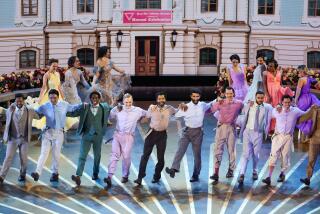KATHAK FESTIVAL BRINGS DANCES OF INDIA TO L.A.
- Share via
Among the classic dance forms of India, the Kathak style of the North may well be the most directly accessible to American dance audiences.
Yes, Kathak programs include arcane tales of supernatural battles between demons and divinities. But, for once, the expressive vocabulary isn’t so intricately stylized to be either intimidating or confusing to the uninitiated.
More to the point, the emphasis on the dancer’s technique is something any ballet aficionado can easily appreciate; the intricate formal structures in the choreography strikingly parallel the formalism of post-modern dance; the spontaneous interplay between dancer and drummer generates the same rhythmic power that has inspired the recent tap revival here.
On Sunday, these facets of Kathak were generously explored in a 4-hour “Festival” at the Japan America Theatre--a performance overladen with ritual speeches of welcome, of introduction, of tribute, of thanks, yet memorable for the joyous collaboration between the eminent Birju Maharaj and the extraordinary Zakir Hussain.
Wearing five pounds of brass bells on each ankle, Maharaj detonated percussive cascades with every step--and these were answered by the virtuosic tabla (small drums) of Hussain. Arms flying, Maharaj would dart or whirl intensely, Hussain would pound out a shifting, slippery rhythmic collage--and both reached an explosive sudden-death termination at the same precise end-beat.
In contrast to other Kathak soloists who have appeared locally, Maharaj danced with an easy, idiosyncratic mastery and great humor: the Honi Coles of Kathak. He also proved a highly gracious guide to his art, counting out rhythmic patterns, demonstrating key mime motifs in an upcoming narrative solo and keeping the educational process free of condescension.
Hussain also accompanied Anjani Ambegaokar, the Los Angeles-based Kathak dancer who organized the festival through her Sundar Kala Kendra Foundation. Ambegaokar danced with her usual exciting drive and technical flair, as if always intent on proving herself, but when she relaxed something exceptional occurred.
In the sensual “Thumri” solo, she achieved a degree of physical transformation--her face suddenly younger, radiant even in repose--that neither the accomplished (and awesomely beautiful) Saswati Sen nor even Maharaj himself matched in their own, distinguished narrative solos.
Besides Sen, Maharaj’s 13-member troupe boasted several exceptional dancers (most notably Krishnan Mohan Misra), while, at the very least, the five local students appearing with Ambegoakar served notice that Kathak can thrive far from the far pavilions.
More to Read
The biggest entertainment stories
Get our big stories about Hollywood, film, television, music, arts, culture and more right in your inbox as soon as they publish.
You may occasionally receive promotional content from the Los Angeles Times.










